This article will be easier to follow if you have watched Part 1 and Part 2 of the weekly scheduling videos. Following the guidelines in these videos you will be able to produce and maintain a work order backlog in priority order, as shown below.
Prioritized backlog:
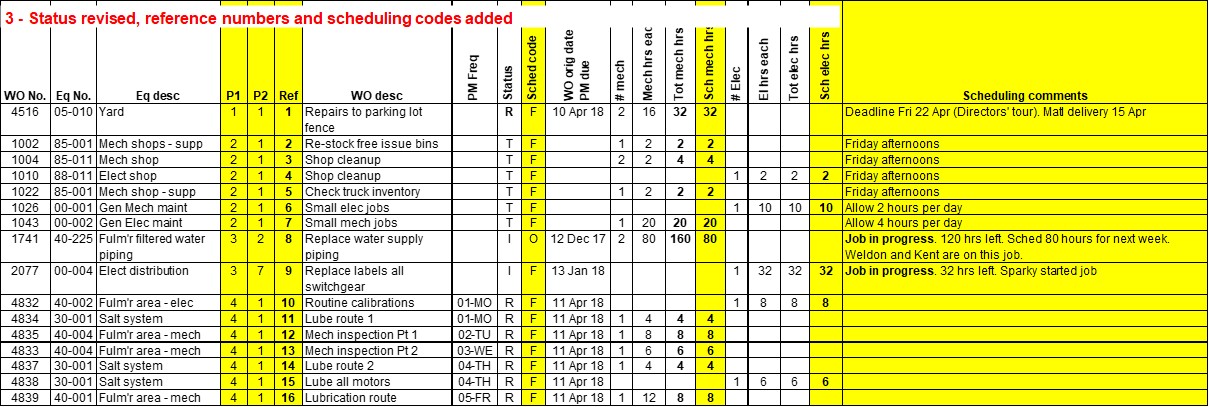
You will then be able to use the backlog list’s reference numbers to produce a graphical weekly schedule that looks like this:
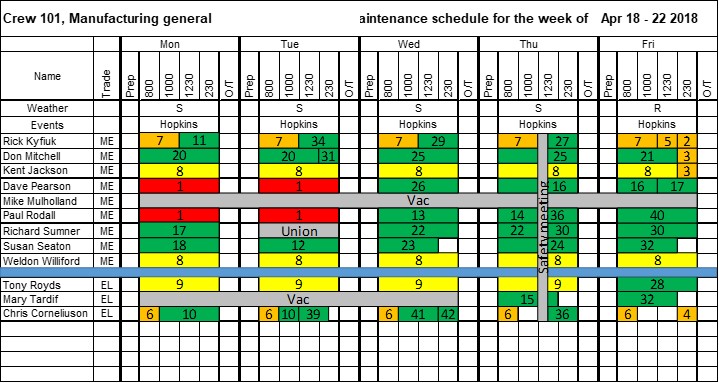
This article assumes that each operating area has a Maintenance Supervisor and an Operations Coordinator (or similar titles) with joint responsibility for setting priorities and scheduling work, and that a weekly scheduling cycle is in place for managing routine, non-shutdown maintenance work. The environment is assumed to be a 24/7 process manufacturing operation, but need not be.
If the process described in the videos is followed, late each week, perhaps Thursday afternoon, the weekly work schedule for the following week will be published. This shows what is possible to achieve with the available tradespeople and with the conditions that existed when the schedule was issued.
Before Monday morning, those conditions will almost always have changed so the schedule will need to be revised. The changes in conditions may include:
– problems that have occurred in the plant that have sufficient urgency to justify breaking into the schedule to make the necessary repairs
– work that was expected to be completed last week but was not completed
– work on last week’s schedule that took less time than expected and allowed some of this week’s work to be started on Friday and
– changes to estimated times that result from changes in conditions, such as equipment operating schedules, weather, etc.
Similar changes may occur on each day of the week, so to maintain a realistic work programme that operating and maintenance people may depend on to make their own plans, a daily work schedule is essential.
While the primary goal is to always be working on the highest-priority work overall, a strong secondary goal is to complete as much of the highest-priority work on the weekly schedule as possible.
On Monday morning, the daily work schedule should be prepared by the Operations and Maintenance supervisors before the maintenance tradespeople arrive so that they can be re-assigned as necessary.
For every other day of the week, the Maintenance and Operations supervisors should meet in the afternoon to agree on the work to be done the next day, and may make further small changes each morning.
While the preparation of the weekly schedule requires considerable concentration and should be done by someone who knows the work and can set aside the necessary time to do this important function without interruption (such as the Area Planner), the daily work schedule should be prepared by the Maintenance Supervisor. It should be based on the weekly schedule as much as possible and should not require a lot of time to prepare and issue.
There are a number of options for preparing a daily schedule. My preference is for a two-day rolling schedule, updated each afternoon, as it helps to maintain work continuity and takes into account events that may affect the work that is done each day. These events include personal absences, area shutdowns, material deliveries and coordination with other support trades. Daily schedules should show more detail than the weekly schedule. If the work order is for a job that will take several days, the “Scheduling comments” should show what part of the job is scheduled for the next day. For example, if the work order description is “Raw material warehouse – Replace the service water piping”, the daily schedule may show “Second floor, east wall, working from the SE corner”.
The tool used to prepare daily schedules is usually a spreadsheet. Critical-path software, such as MS Project, can be used but is not very suitable for routine maintenance work (See “Scheduling – Spreadsheets or Critical-Path software?”). The technique used depends on the Supervisor’s comfort in working with spreadsheets, and here are a couple of options, both based on the weekly scheduling process shown in the videos.
- Graphical daily schedule.
Using the techniques shown in Part 2 of the scheduling video, make a copy of the weekly schedule, delete all the days except the next two. Copy the relevant numbered text boxes from the weekly schedule and paste them on the daily schedule, taking into account the known changes.
Where unscheduled work must be added, include and highlight these work orders in the backlog list to reflect their priority but use letters instead of numbers in the “Reference” column to distinguish them from scheduled work and use the purple text boxes on the graphic schedule. This makes the changes obvious.
Unscheduled work, where practical, should displace the work on the weekly schedule with the highest reference numbers, i.e. the least urgent work. Of course, the impact on coordination with other crews, planned equipment shutdowns, personal trades skills and all the other factors that affect scheduling need to be taken into account.
The updated backlog will then look like this – note that the two daily changes are identified as “A” and “B” in the “Ref” column:
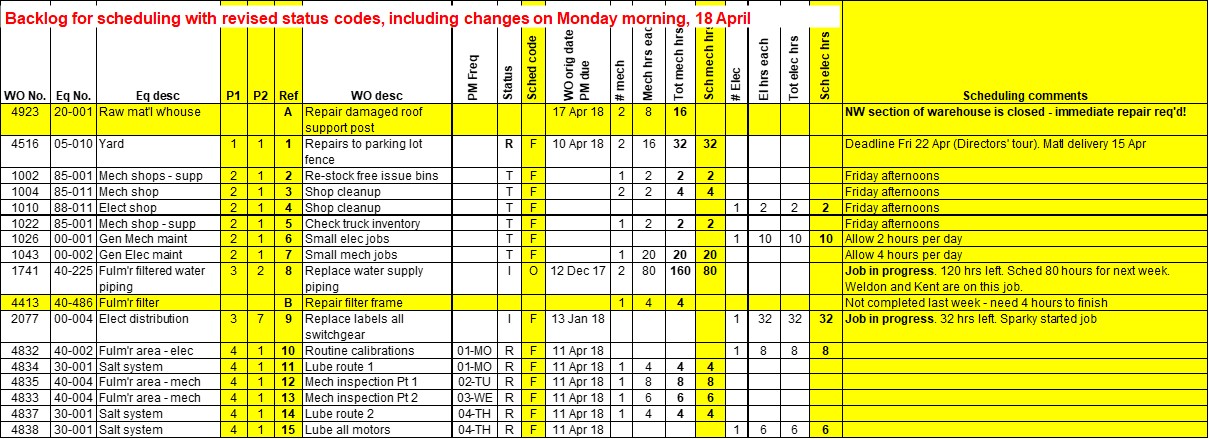
The text boxes for any work that is displaced by unscheduled work should be moved to a holding column for rescheduling when the next daily schedule is prepared.
A daily work schedule based on the weekly graphic schedule and adjusted for some of the changes mentioned above is shown below.
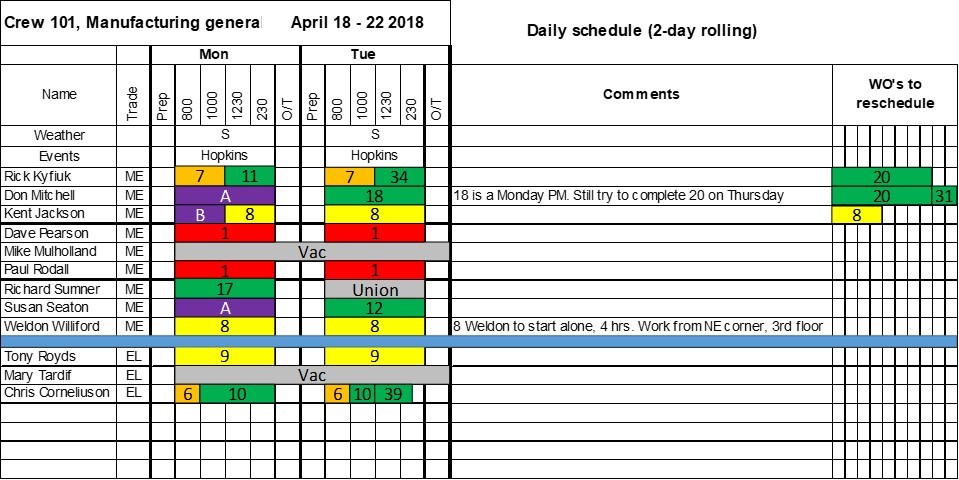
2. Marked-up backlog list
Another option is to just use the prioritized scheduling backlog and add columns to enter the assigned tradespersons’ names and starting and ending times, as estimated when the daily work schedule is prepared. An example is shown below, accommodating the same changes that are shown in the above graphic daily schedule. The columns that are no longer needed for preparing the daily schedule have been hidden in the spreadsheet.
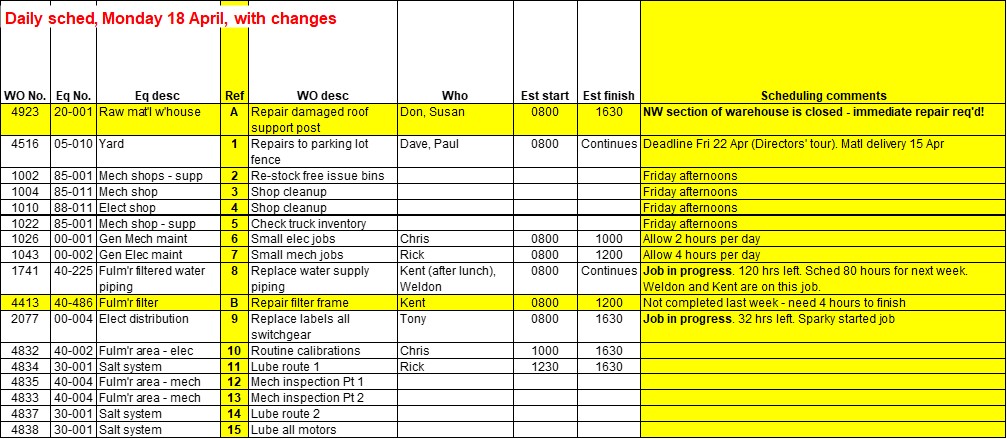
There are several other ways to prepare daily schedules and the process adopted should be the one with which the Maintenance Supervisor is most comfortable. However, the daily schedule should, ideally, meet the following minimum requirements:
– It should show which work is to be done the next day
– It should show which tradespeople are assigned to each work order
– It should show estimated times
– It may show some detail of which part of longer jobs will be executed the next day
– It must take into account the same scheduling limitations that apply to the weekly schedule (material deliveries, etc)
– It should be in a format that can be easily shared with interested people, such as control room operators and tradespeople. Storing the daily schedule on your server with “read only” access by anyone is probably the best way to achieve this.
Because the unscheduled work that is done is identified by a letter instead of a number in the backlog, and by purple text boxes if a graphic schedule is used, this unscheduled work can be tracked and makes a useful KPI. Some follow-up to find out why the work was not scheduled can lead to improved maintenance performance, increased reliability and may also lead to improvements in business processes.
The daily schedule should become the most important document for maintenance supervisors and their tradespeople for controlling the work that is done, and the development of a good daily scheduling process will probably take some time and effort.
Its worth noting that the information that is shown on the daily schedule is the same as that required to record the information that is usually entered on individual tradespeople’s timesheets. An alternative to requiring tradespeople to record their time each day, which may take considerable time, is for the Maintenance Supervisor to adjust the daily schedule at the end of the day to reflect the work that was actually done, show other changes (such as unexpected absences) and submit that information for recording of work order labour costs, but only if it is decided that such a record is of value (see “Why bother to measure maintenance costs?“).
The scheduling process, once established as a routine, has the potential to greatly improve maintenance effectiveness, maintenance materials management and overall service to the operation.
Its worth repeating that the biggest threats to scheduling come from “fire-fighting” managers who allow or even encourage new work to break into the weekly and daily schedules where it is not truly justified. Managers must challenge such work, especially if it is apparent that the work could have been anticipated in time to be scheduled. One great advantage of the graphic weekly schedule is that it is very visible and the impact of any changes can be easily seen. It also demonstrates that Maintenance is in control and does have a rational process for deciding which work will be done and when.
To return to the articles list, click here.
Don Armstrong, P. Eng
President
Veleda Services Ltd
250-655-8267 (Pacific Time)
©Veleda Services Ltd